You can repair broken STL files using three effective methods: automated software tools like Meshmixer and Netfabb that quickly fix common issues like holes and mesh errors, manual editing techniques in programs like Blender for precise geometric corrections, or convenient online repair services that automatically detect and fix problems without requiring specialized software. Each approach offers distinct advantages—automated tools save time, manual editing provides precision control, and online services offer cost-effective solutions for quick fixes that’ll help you master ideal repair strategies.
Use Automated STL Repair Software Tools

When you’re dealing with corrupted STL files, automated repair software tools like Meshmixer and Netfabb provide the most efficient solution for identifying and fixing common mesh errors.
These automated STL repair software programs feature user-friendly interfaces that simplify the repair process greatly. You’ll benefit from auto-repair functions that quickly resolve major issues like holes and separate shells, saving considerable time compared to manual repairs.
Most tools include mesh analysis capabilities, allowing you to inspect file integrity and pinpoint specific errors requiring attention.
Advanced software like Netfabb offers additional features including wall thickness analysis and mesh triangle count optimization.
Apply Manual Mesh Editing Techniques
While automated tools handle most STL repairs efficiently, manual mesh editing techniques give you complete control over complex corrections that require precise intervention.
Manual mesh editing provides precision control when automated STL repair tools fall short of handling complex geometric corrections.
You’ll use software like Blender to directly manipulate mesh geometry, allowing precise repairs such as deleting problematic triangles or creating new ones to fix errors.
The knife tool helps you cut through intersecting geometry, creating cleaner edges and resolving overlaps.
Vertex and edge selection tools let you identify and modify specific problem areas while maintaining your model’s integrity.
Recalculating normals guarantees your mesh surfaces face the correct direction for proper printing.
Boolean operations enable you to combine or subtract mesh sections, effectively merging separate parts or removing unwanted geometry to create a manifold mesh ready for 3D printing.
Leverage Online STL Repair Services

Online STL repair services provide a convenient alternative when manual editing becomes too time-consuming or when you need quick fixes without specialized software knowledge.
These platforms automatically detect common mesh errors like holes and non-manifold edges, making them perfect for beginners working with STL files. You can upload your models directly, analyze issues instantly, and preview repairs before downloading corrected versions.
Many services repair STL files for free, offering cost-effective solutions for 3D printing preparation.
Beyond basic fixes, you’ll find additional tools that optimize triangle counts and enhance mesh integrity. Since effectiveness varies between platforms, you should test multiple services to find what works best for your specific needs and repair requirements.
Frequently Asked Questions
How to Fix a Damaged STL File?
Start by running auto-repair functions in Meshmixer or Netfabb to fix holes and shells. You’ll need to analyze for manifold errors, manually delete problematic triangles, and preview results before finalizing your repairs.
What Is the Best Program to Repair STL Files?
You’ll find Meshmixer’s the best choice for most users due to its user-friendly interface and versatile repair functions. If you’re an engineer, Netfabb’s automated repair options efficiently handle complex mesh errors.
How to Rework STL Files?
You’ll rework STL files by using auto-repair functions first, then analyzing for manifold errors. Apply Boolean operations for geometry adjustments, manually delete problematic triangles, remesh sections, and save frequently throughout the process.
How to Repair Stl Using Meshlab?
Import your STL file through File → Import Mesh. Use Filters → Cleaning and Repairing to remove duplicates, fill holes, and fix geometry issues. Export the repaired model as STL format.





Leave a Reply